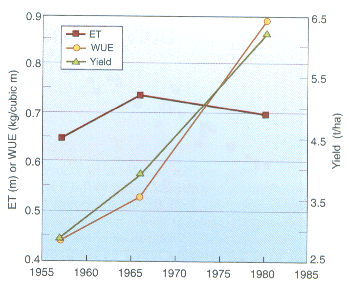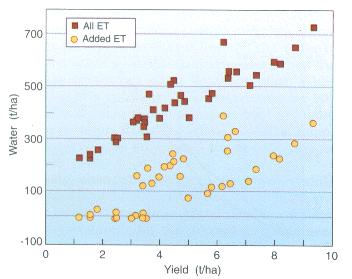While admitting the reasons for the conventional, pessimistic view of irrigation's future, I nevertheless inquire whether it might be brighter. An Indian scientist wrote, ``In India it is claimed that 10 million hectares of land has been water-logged whereas remote sensing surveys through satellite imagery show that not more than 1 million hectares of land has been water-logged and gone out of use." (Parikh, 1993b[Par3b])
Next I recall that although the average global evaporation would grow enough food to feed 400 billion, raising the dry places to average requires vast volumes of water. Energy cheap enough to move the needed volume from wet to dry places would, of course, ease the problem. Pumps have demonstrated how cheap energy expands irrigation. During the past generation, energy to pump water expanded use of ground water. Although cheap energy prompted so great an expansion that it lowered the water in some aquifers, it nevertheless demonstrated how the energy to move water solves water shortages. While water that lifts yields, as the difference between 300 and 750 mm did in the crops represented in Figure 9.1.1, may require dams and canals as well as pumps and energy, it also diminishes the need to expand cropland.
Clearly, abundant energy to move water could
spare more land for Nature by relieving drought and
raising yields on present cropland. The World Bank
(1990[Ban90])![]() estimates that the present irrigated area
could be expanded by about half, more in less developed
and less in more developed countries. A scientist
(Ahmad, 1987[Ahm87], 24) with the authority of working
on the ground of a developing country confirmed the
Bank's opinion by writing, ``Fortunately, there is a
tremendous potential for developing the water resources
of Pakistan to meet the rapidly growing demand
for this vital agricultural input."
estimates that the present irrigated area
could be expanded by about half, more in less developed
and less in more developed countries. A scientist
(Ahmad, 1987[Ahm87], 24) with the authority of working
on the ground of a developing country confirmed the
Bank's opinion by writing, ``Fortunately, there is a
tremendous potential for developing the water resources
of Pakistan to meet the rapidly growing demand
for this vital agricultural input."
Postel captured the second reason for hope in her title the Last Oasis, which refers to the water saved by improved efficiency. Because irrigation consumes much of the water that humanity draws, she began her chapters about making water go farther with thrifty irrigation. Engineering to save water on the way to the soil around roots leads her list and the lists of others. Lining, metering, and timing, and then trickle, drip, and surge are key words. Incentives of ownership and price encourage efficient delivery of water to soil.
A survey (Rangeley, 1987[Ran87], 32) of present efficiencies shows the room for improvement:
Application efficiencies vary from 35 to 75 percent and conveyance efficiencies from 30 to 90 percent. Overall efficiencies fall mostly between 10 and 50 percent. Many large surface systems in Asia have efficiencies about the middle of those ranges or about 30 percent compared with about 37 percent in some developed countries. By contrast the more advanced drip systems achieve 85 percent and sprinkler systems in developed countries have overall efficiencies of about 60 percent.
So-called micro systems of irrigation, which are evoked by the word trickle, improve further on the conventional sprinklers. They typically apply one-quarter to one-half less water than sprinklers to produce the same yield of fruits, nuts, and many vegetables. Because micro systems operate at low pressure, they save energy as well as water compared to conventional sprinkling, they typically halve the pumping costs. Their capacity for applying fertilizer and some pesticides along with the irrigation water lessens drift and leaching (Stewart and Nielson, 1990[SN90]).
The advanced systems are applied mainly in industrialized countries or where crops of high value are grown. Improving technology and valuable crops are, of course, the very means needed to spare land.
At this point, I repeat my cautionary note. Water from irrigation that percolates to an aquifer or reaches a stream and is recaptured by a pump or a farmer downstream is not lost to a region. So improving efficiency upstream without diminishing evaporation can decrease supply downstream, making the gain in efficiency illusory for the region as a whole. Nevertheless, Postel's Last Oasis of efficiencies in delivering water to roots is not a mirage.
Clearer opportunities for improving efficiency lie in the conversion of soil water to crop because there is a goal beyond water in soil, food.
``Water cannot be considered to have become a real constraint to meeting the world food supplies as long as there is the scope for manipulation of the various underlying factors for further increasing the agricultural production" (Ahmad, 1987[Ahm87], 23). If one looked for a crop that transpired less or was less sensitive to drought, he would be disappointed at the small differences among species (Doorenbos et al., 1986[DK86]). Instead, one finds the first opportunities in increasing the fraction of soil water that a crop transpires rather than evaporates from soil or weed. Opportunities are found next in ensuring that no factor such as genetics or fertility limits photosynthesis. Finally, they are found in raising the fraction of photosynthate that is food.
The simple fact that water below a threshold produces
no yield at all means that adding water can
paradoxically improve water use efficiency.![]() Figure 6.3.2 showed about 100 mm of water evaporated with
no yield. With less than 100 mm, the yield per water,
which is called water use efficiency, was zero.
Adding water above this threshold produced more
and more grain, increasing water use efficiency further
and further above zero. The 100 mm of water is
like a fixed overhead in a business that can paradoxically
allow rising expense to improve the percentage
of profit. Two specific examples: In Figure 6.3.2, irrigation
that raised sorghum
yield by 1 t/ha also raised
water use efficiency by 0.1. Higher efficiencies also
went with higher yields of corn in five U.S. states
(Jensen, 1984[Jen84], 142-166).
Figure 6.3.2 showed about 100 mm of water evaporated with
no yield. With less than 100 mm, the yield per water,
which is called water use efficiency, was zero.
Adding water above this threshold produced more
and more grain, increasing water use efficiency further
and further above zero. The 100 mm of water is
like a fixed overhead in a business that can paradoxically
allow rising expense to improve the percentage
of profit. Two specific examples: In Figure 6.3.2, irrigation
that raised sorghum
yield by 1 t/ha also raised
water use efficiency by 0.1. Higher efficiencies also
went with higher yields of corn in five U.S. states
(Jensen, 1984[Jen84], 142-166).
Improving efficiency by 0.1 is substantial for a parameter near 1 g/kg, that is, 1 kg grain/m of water. I cite some examples from dry 1980, when only 103 mm of precipitation fell on Texas sorghum. Precipitation alone produced a water use efficiency of only 0.5-0.7 g/kg. Adding 130-190 mm irrigation water to other plots raised their water use efficiency to 0.8-1.0, and adding 250-530 mm to still other plots raised theirs to 1.0-1.2.
Paradoxically, even adding irrigation water raised the efficiency of water use by the sorghum of Figure 6.3.2.
Winter wheat grown at Bushland, Texas illustrates that conversion of soil water to food can be improved. In experiments spanning 30 years, the consumption of soil water by evapotranspiration from soil and plants changed little. Because the harvest of grain doubled, however, the efficiency of water use doubled (Figure 9.3.1.).
 Figure 9.3.1. The steady evapotranspiration, ET, rising yield of
wheat and hence rising water use efficiency, WUE,
at Bush land, Texas. Observations of several
reported by Jensen (1987, 45). [Jen87]
Figure 9.3.1. The steady evapotranspiration, ET, rising yield of
wheat and hence rising water use efficiency, WUE,
at Bush land, Texas. Observations of several
reported by Jensen (1987, 45). [Jen87]
My final opportunity for making water go farther is a paradox: irrigate where it rains. After examining the difficulties of raising the g of biomass per kg of water transpired by a crop itself, reviewers wrote, ``Irrigation and full exploitation of humid environments are seemingly of highest priority in attempting to increase food production in view of the conservative nature of crop water-use efficiency" (Sinclair et al., 1984[STB84]).
Why irrigate to supplement precipitation rather than providing virtually all the water in an arid place? First, the water of the humid environment supplies the fast evapotranspiration that improves water use efficiency. In Texas, water use efficiency of sorghum doubled when water supply increased evapotranspiration from 250 mm to more than 700 mm; similarly in maize in five states, water improved water use efficiency. I conclude with a simpler rationale for irrigation in humid places: rain provides part of the water, for free. The squares in Figure 9.3.2 show all water (precipitation plus irrigation) consumed in Texas to produce yields of sorghum from 1 to 9 t/ha. The steady rise from 1 t/ha sorghum taking 200 mm water to 9 t/ha sorghum taking 700 mm shows anew the iron connection between yield and water. In a completely dry place, irrigation would have had to furnish all the water consumed. But precipitation fell on the sorghum fields of this figure, and irrigation furnished only the millimeters of water shown by the circles in the figure. At each yield from 1 to 9 t/ha, precipitation furnished the difference between the higher squares showing all the water consumed and the lower circles showing the extra consumption by irrigated sorghum. Precipitation provided that difference, for free.
 Figure 9.3.2. The evapotranspiration, ET, consumed by growing
sorghum near Bushland, Texas in 1979,1980, and
1981. Producing yields of 1 to 9 t/ha, the sorghum
consumed the quantities All ET of water (squares).
The quantities Added ET(circles) are the additional
water that crops consumed because they were
dairrigated. Several crops yielding 1 to 4 t/ha were not
irrigated and provide the standards for calculating
the Added ET. The differences in consumption
between squares and circles are attributed to
precipitation (Stewart et al., 1983). [SMD83]
Figure 9.3.2. The evapotranspiration, ET, consumed by growing
sorghum near Bushland, Texas in 1979,1980, and
1981. Producing yields of 1 to 9 t/ha, the sorghum
consumed the quantities All ET of water (squares).
The quantities Added ET(circles) are the additional
water that crops consumed because they were
dairrigated. Several crops yielding 1 to 4 t/ha were not
irrigated and provide the standards for calculating
the Added ET. The differences in consumption
between squares and circles are attributed to
precipitation (Stewart et al., 1983). [SMD83]